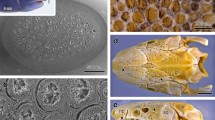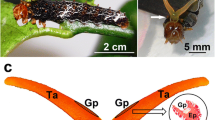Summary
-
1.
Each gland cell of the 3rd abdominal stink gland of the larves of Pyrrhocoris apterus L. has 2 canal cells which form an exit duct for the scent. It is a canal system consisting of “Köpfchen”, “Endblase” and “Sekretkanälchen”.
-
2.
The “Köpfchen” resembles a spongy cushion and is associated with the large vacuole of the gland cell. From here the delivery of the scent takes place into the “Endblase” which is a reservoir. The further transport of the smelling liquid takes place in the “Sekretkanälchen”, a small chitinous canal, into the central lumen of the gland. During the casting of the skin of the larves the whole canal system is removed and after that anew established.
-
3.
The matrix epithelium situated above the gland cells is non — glandular and responsible for the renovation of the gland cells and canal cells during the casting of the skin of the larves and for the genesis of the chitinous intima of the gland. The matrix epithelium also contains large quantities of red pigment.
-
4.
Between the gland cells intermediate cells are situated, which lend support.
-
5.
The dorsal epithelium of the stink gland consists of a layer of non-glandular cells which contain much red pigment.
Zusammenfassung
-
1.
Jede Drüsenzelle der 3. larvalen Abdominaldrüse von Pyrrhocoris apterus L. steht durch 2 Kanalzellen mit dem Drüsenlumen in Verbindung, die das Sekret ableiten und jeweils aus einem Köpfchen, einer Endblase und dem Sekretkanälchen bestehen.
-
2.
Das Köpfchen grenzt als schwammartig strukturiertes Polster eng an die Sammelvakuole der Drüsenzelle an und vermittelt den Sekretdurchtritt in die sich anschließende Endblase, die als Reservoir dient. Von hier aus erfolgt der Transport durch das stark gewundene Sekretkanälchen in das Drüsenlumen. Bei der Häutung der Larven wird der gesamte Ausleitungsapparat abgestoßen und danach wieder neu angelegt.
-
3.
Das oberhalb der Drüsenzellen gelegene Matrixepithel besitzt keine Drüsenfunktion, sondern sorgt für die Erneuerung der Drüsen- und Kanalzellen bei dem Häutungsprozeß. Sie ist ferner für die Bildung der chitinigen Intima des Drüsensackes verantwortlich und enthält große Mengen eines roten Farbstoffes.
-
4.
Die Zwischenzellen, die die Drüsenzellen voneinander trennen, sind Differenzierungen des Matrixepithels und haben vermutlich Stützfunktion.
-
5.
Die dorsale Begrenzung des Drüsensackes besteht aus einem einschichtigen Epithel, das keine Drüsenfunktion hat und relativ viel rotes Pigment enthält.
Similar content being viewed by others
Literatur
Henrici, H.: Die Hautdrüsen der Landwanzen (Geocorisae), ihre mikroskopische Anatomie, ihre Histologie und Entwicklung. Teil I. Die abdominalen Stinkdrüsen, die Drüsenpakete und die zerstreuten Hautdrüsen. Zool. Jb., Abt. Anat. u. Ontog. 65, 123–294 (1938).
Stein, G.: Über den Feinbau der Duftdrüsen von Feuerwanzen (Pyrrhocoris apterus L., Geocorisae). I. Mitt. Zur funktionellen Morphologie der Drüsenzelle. Z. Zellforsch. 74, 271–290 (1966).
Author information
Authors and Affiliations
Additional information
Herrn Prof. Dr. R. Danneel zum 65. Geburtstag gewidmet.
Herrn Prof. Dr. R. Danneel und Herrn Prof. Dr. K. E. Wohlfarth-Bottermann danke ich für wertvolle Anregungen, Fräulein H. Urmes und Herrn K. J. Medved für technische Assistenz.
Mit Unterstützung durch die Deutsche Forschungsgemeinschaft.
Rights and permissions
About this article
Cite this article
Stein, G. Über den Feinbau der Duftdrüsen von Feuerwanzen (Pyrrhocoris apterus L., Geocorisae). Zeitschrift für Zellforschung 75, 501–516 (1966). https://doi.org/10.1007/BF00341508
Received:
Issue Date:
DOI: https://doi.org/10.1007/BF00341508




